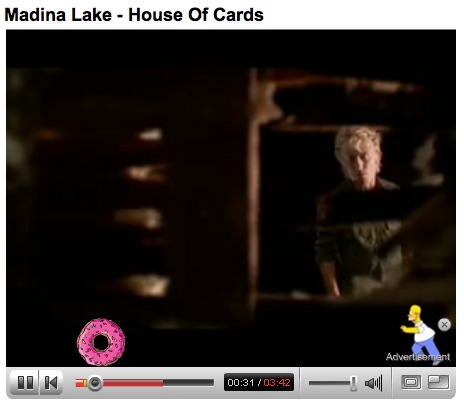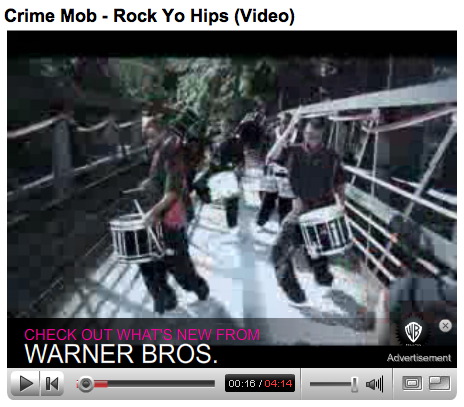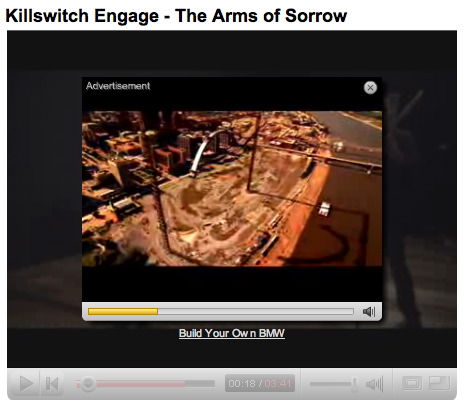 Online video needs a business model. So does most of new media. So Google’s attempt to bring advertising to select YouTube clips, unveiled today, is just another step in that direction.
Online video needs a business model. So does most of new media. So Google’s attempt to bring advertising to select YouTube clips, unveiled today, is just another step in that direction.
And you know what? The ads are not that bad, all things considered.
After months of testing various video advertising formats, Google settled on an approach that it hopes is less obtrusive to viewers and keeps them in control of what they’re watching. It’s similar to the “ticker ad” concept that VideoEgg introduced nearly a year ago, or the ads that appear along the bottom of the screen during television shows.
The Google ads will be shown only on videos made by YouTube’s 2,000 to 3,000 professional content partners and the 70-odd members of its member partner program, although it’s not far-fetched to think that the ads will appear on user-generated, non-professional video once the process of matching ads to appropriate content are worked out.
 Fifteen seconds into a video, a transparent overlay, produced in Flash, appears on the bottom 20 percent of the screen. It depends on the ad creator’s sensitivity as to how in-your-face the ads are: Steve Carell’s head and the bold type face of “Evan Almighty” are pretty intrusive, while the “check out what’s new” from Warner Bros. ad on a Crime Mob “Rock Yo Hips” music video is acceptable.
Fifteen seconds into a video, a transparent overlay, produced in Flash, appears on the bottom 20 percent of the screen. It depends on the ad creator’s sensitivity as to how in-your-face the ads are: Steve Carell’s head and the bold type face of “Evan Almighty” are pretty intrusive, while the “check out what’s new” from Warner Bros. ad on a Crime Mob “Rock Yo Hips” music video is acceptable.
Viewers can click on the banner to view the ad, close the banner, or ignore it and the ad disappears after 10 seconds. If one clicks on the banner, the video pauses and the Flash ad plays on top in a translucent box that takes up 80 percent of the video (BMW/Killswitch Engage example). Clicking on the ad takes a viewer to a dedicated Web page. If once the ad has started playing and it’s of no interest, a viewer can bail and return to the video by clicking the “X” in the upper right corner.
 If viewers do not want to watch the ad from the start, they can click the “X” in the upper right corner of the banner and it will disappear. Ignoring the ad for 10 seconds, while the video plays, will also close it.
If viewers do not want to watch the ad from the start, they can click the “X” in the upper right corner of the banner and it will disappear. Ignoring the ad for 10 seconds, while the video plays, will also close it.
“What we have come up with is a user-controlled ad format that is engaging,” says Eileen Naughton, Google’s director for media platforms. “We want our users to be able to accept and choose what type of advertising they engage in.”
No matter what Google decided to do, it was going to be controversial. Some people think there should be no advertising attached to YouTube videos for fear that it might alienate its viewers. With 51 million users in June (Nielsen/NetRatings), YouTube attracts an audience that is larger than the combined audiences of its three nearest competitors — MySpace, AOL, and Yahoo (New York Times).
But it’s no secret that Google had to weigh user concerns against investor issues to find an appropriate monetization strategy following its $1.65 billion buyout of YouTube in October 2006. Google has to keep keep the user community happy while allaying investor fears.
For the past several months Google has been testing other ad approaches, including “pre-rolls” (ads that appear before a video), but the in-player, during-the-video approaches tested best. Shashi Seth, YouTube’s group product manager, noted that the ads performed “5 times to 10 times” better than traditional display advertising. Though YouTube is not charging on a performance basis — ads are sold for $20 CPM (a cost per thousand impressions) — 75 percent of tested viewers who clicked on an ad watched it to its conclusion.
Whether viewers like Google’s YouTube ads, only time will tell. But no matter what happens, advertising is here, it’s always been here, and it will find its way into online video and new media. Google’s attempt, while not perfect, is palatable and a start.
Other examples include: How to: Create an evening look in minutes (“Hairspray”), and Madina Lake’s video “House of Cards” (“The Simpson’s Movie”).
[Ed. I’m not seeing the YouTube ads here in the UK, so I suspect they are geo-targeted. If any readers can confirm this, please leave a comment.]

Check this youtube gadget.
http://padmanijain.googlepages.com/myexperiments.html
I believe they are geo-targeted, as I don’t see them here in East Europe.
Which is a good thing, since knowing that most of the early adopters for this method will be targeted towards U.S based households which leaves the rest of the world without ads for a little bit longer.
Doesn’t seem to be too intrusive at all…and especially if they are contextualized, could even make them useful.
Not bad? They’re horrible! I hated when similar ads came in the middle of TV shows now they are popping up on YouTube! At least with YouTube you can close the ad right away. I think ultimately the InVide advertising on YouTube will be a complete failure -> http://www.russellheimlich.com/blog/why-youtube-video-ads-will-ultimately-fail/
YouTube ads have finally made their debut, but I don't think it's all it's cracked up to be in fact I am seeing better results from Adwido, and it's a relatively new advertising network. I think it's because there isn't nearly as much competition.
Los consumos también son considerablemente inferiores.